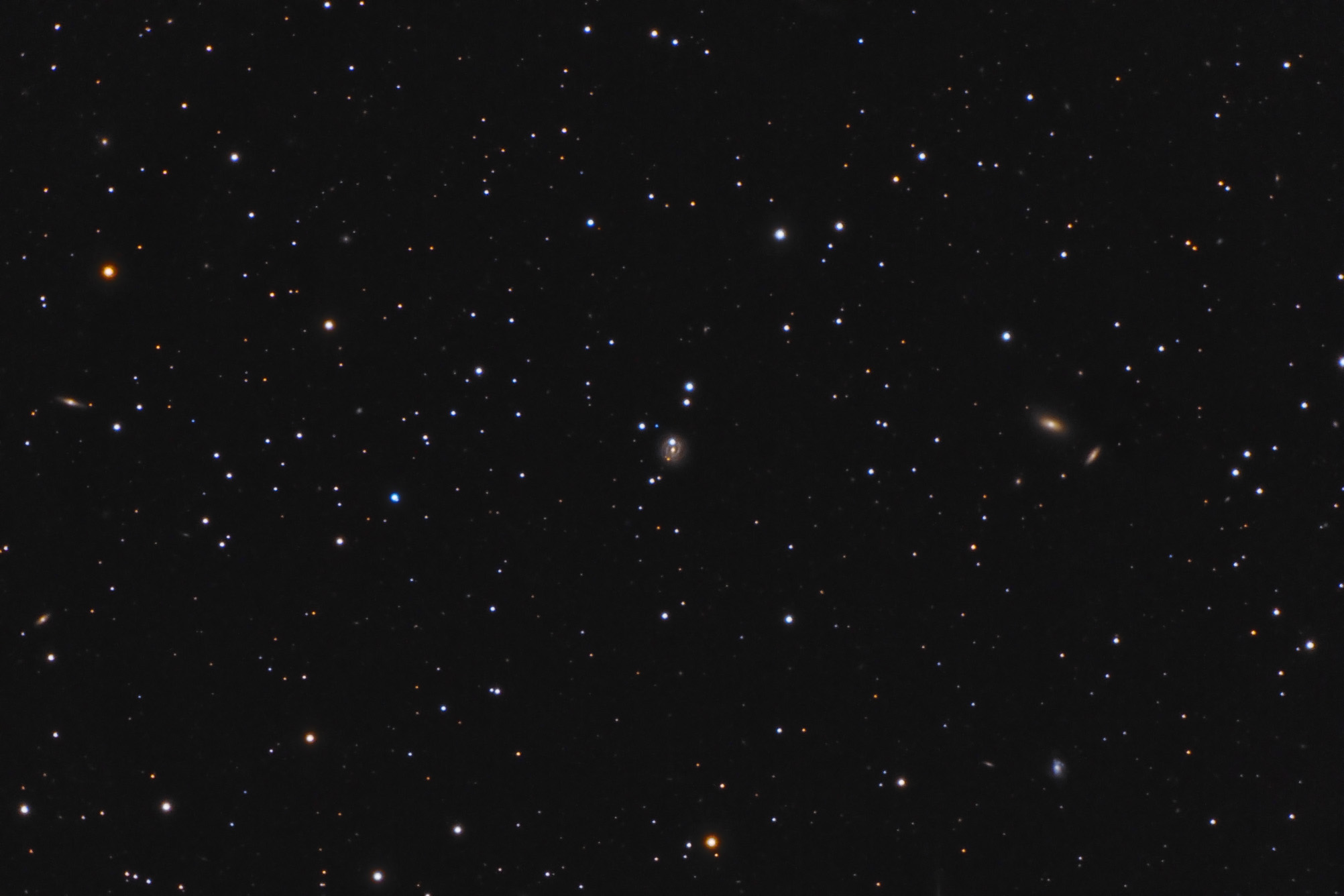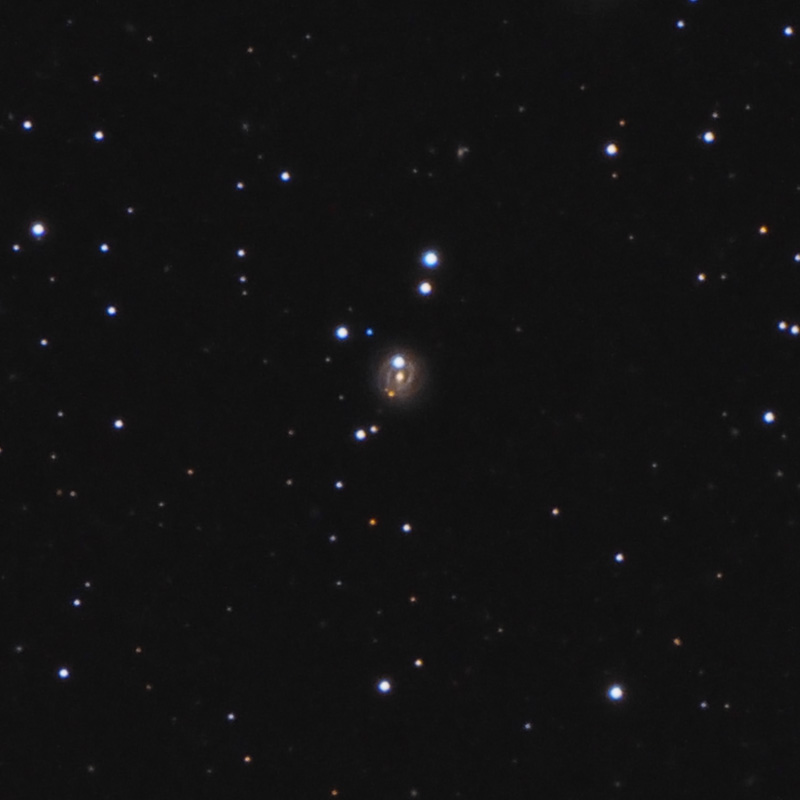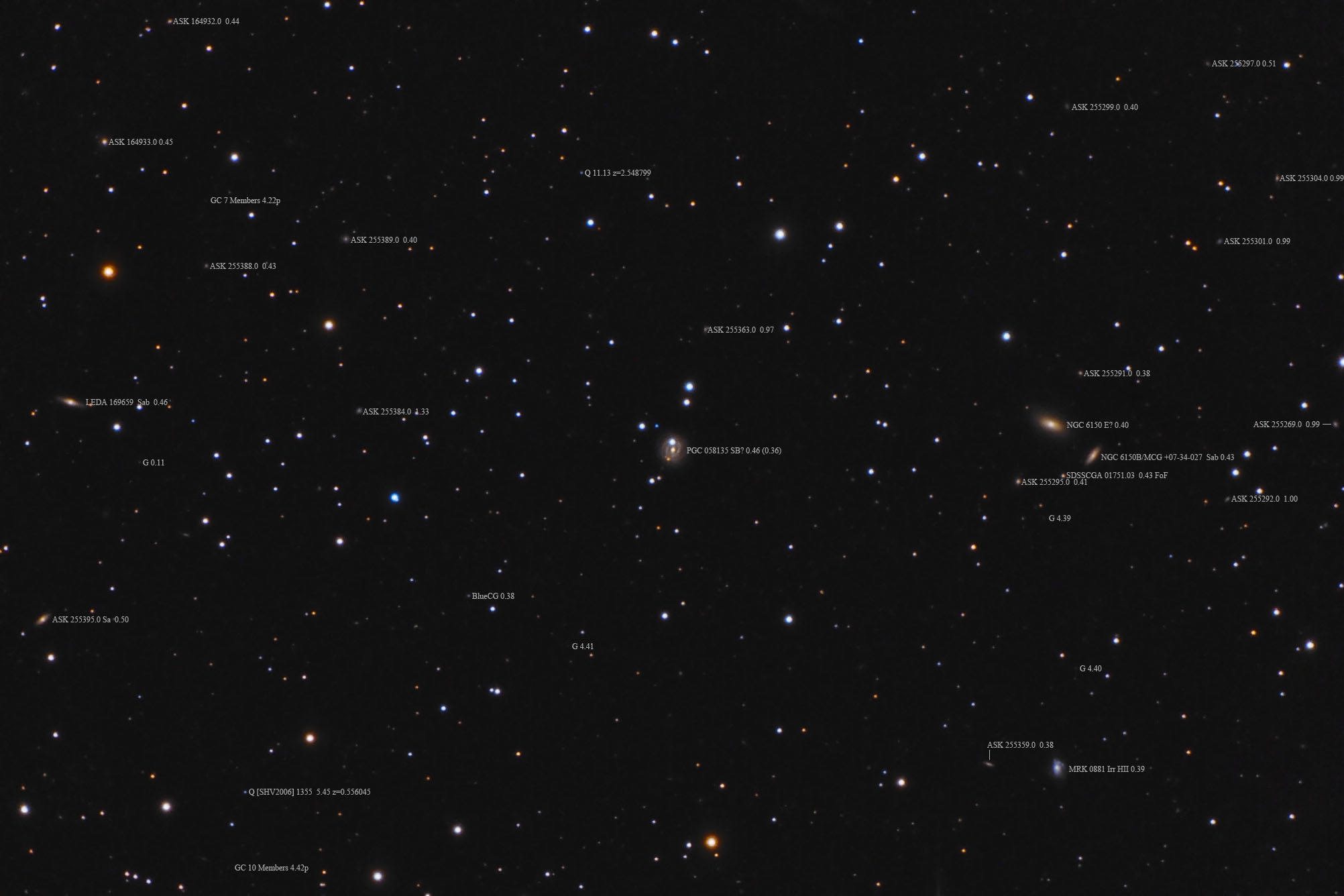Object name: PGC058135Designation(s): PGC058135, NGC6150, This field is located in Hercules. It is on the north-northwest edge of Abell 2199 and the south-southwest edge of Abell 2197 galaxy clusters. Both have a distance estimate of about 410 million light-years. This accounts for the majority of the galaxies in the field being at about this distance.
My original target was the pair of galaxies known as NGC 6150. When I checked the field I saw a several other interesting looking galaxies in the field and decided to record the aim point as being PGC 58135 to pick them all up. In the 10 second image I used to check the frame it appeared very strange to me. Turns out I was fooled by a bright star at the north end and a fainter one at the southern end. Unfortunately, these cover some likely interesting detail. While the galaxy looks to have a ring structure I doubt that it is real. It is a barred spiral in which the north arm suddenly bends left. This is hidden by the bright blue star. Then it runs on a tangent to a similar arm coming from the southern end of the bar. This is hidden behind the orange star. The arm then flares outward ending about where I put the label in the annotated image. The southern arm does the same at the northern end of the galaxy, again hidden behind the bright blue star. It then curves on around parallel to the other arm ending just as it reaches the orange star. So it isn't all that odd, just that the stars hiding what's going on give it that appearance.
Redshift puts it a bit more distant than most of the field, at 460 million light-years though two non-redshift measurements using the fundamental plane method put it at only 360 million light-years. I'm a bit lost as to why this method was used. I'd always thought it was designed for elliptical galaxies rather than spiral galaxies. I'm going with the redshift which makes the galaxy about 110,000 light-years in size. A rather large spiral.
NGC 6150 is usually considered only the larger and brighter galaxy with the fainter sometimes identified as NGC 6150B. Their redshifts differ slightly. I see no sign of interaction between them so suspect they actually aren't related other than being in the same Abell cluster. NGC 6150 was discovered by William Herschel on March 18, 1787. It isn't in either Herschel 400 observing projects. NED and the NGC Project classifies it as E? while Seligman says E5?? NED considers it part of Abell 2199 while the NGC Project says it is in Abell 2197. I'll not take sides here as to me it is just one two-lobed cluster, likely a pair of clusters in the early process of merging. I measure NGC 6150 at about 125,000 light-years across while 6150B is a bit under 90,000 light-years across. It was discovered by William Herschel on March 18, 1787. It isn't in either H400 program.
Below NGC 6150 is a truly strange looking galaxy, MRK 881. NED classifies it as an Irregular galaxy with HII emission, likely due to the two obvious blue star clouds on its northwest side. To me, it looks like a disrupted spiral but I can live with the irregular classification. Though I am bothered by its 90,000 light-year size. Irregular galaxies are normally less than half this size. This is in line with a disrupted spiral.
Southwest of PGC 58135 is a very small galaxy that NED labels a Blue Compact Galaxy. It is rather gray in color in my data. The Sloan data which maps blue to near UV shows it very blue. I suspect most of the blue is from UV which is blocked by my filters. I measure it at 13,000 light-years across its longest dimension. NED, however, sees it larger than I do which results in a 20,000 light-year size. Normally NED's sizes are smaller than mine rather than larger so the difference is a puzzle.
14" LX200R @ f/10, L=4x10' RGB=2x10', STL-11000XM, Paramount ME Related Designation(s):18W 003, 2MASS J16254998+4029194, 2MASS J16263983+4028411, 2MASX J16255000+4029194, 2MASX J16263984+4028417, 2MASXi J1625500+402919, 2MASXi J1626398+402841, 87GB 162408.2+403559, 87GB[BWE91] 1624+4036, ABELL 2197:[DGP89] 0007/7JBR , ABELL 2197:[WCB96] I, ABELL 2197:[ZBO89] O2, ABELL 2197:[ZBO89] R2, ABELL 2199:[DGP89] 5741/9JTR , ABELL 2199:[DGP89] 5743/9JTR , ABELL 2199:[HIV2012] 0739, ABELL 2199:[HIV2012] 0843, AGC 260513, ASK 255296.0, ASK 255356.0, B2 1621+38:[HIV2012] 0654, B2 1621+38:[HIV2012] 0757, B3 1624+405, CALIFA 835, CGCG 1624.2+4036, CGCG 1625.0+4035, CGCG 224-022, CGCG 224-025, FBQS J162550.0+402918, FIRST J162550.0+402918, GALEXASC J162549.94+402917.5 , GALEXMSC J162549.97+402919.5 , GIN 570, HDCE 0948 NED005, HOLM 748A, IRAS F16249+4035, LDCE 1190 NED010, LDCE 1190 NED011, MCG +07-34-029, MCG +07-34-033, Mr18:[BFW2006] 04792 NED45, Mr19:[BFW2006] 09501 NED40, Mr20:[BFW2006] 16089 NED10, NGC 6150, NGC 6150A, NGC6150, NSA 046170, NVGRC J162549.9+402921, NVSS J162549+402921, PGC 058105, PGC 058135, PGC058135, SDSS J162549.96+402919.3, SDSS J162549.96+402919.4, SDSS J162549.97+402919.3, SDSS J162639.84+402841.1, SDSS J162639.85+402841.0, SDSS J162639.85+402841.1, SDSS J162639.85+402841.2, USGC U766 NED39, USGC U766 NED41, UZC J162550.1+402920, UZC J162639.9+402844, WISE J162549.96+402919.4, WISE J162639.85+402841.0, [BFW2006] J246.45818+40.48872 , [DZ2015] 769-02, [DZ2015] 770-02, [GMM2009] 0706363, [HIV2012] 1593, [HIV2012] 1697, [HIV2012] 5922, [HIV2012] 6025, [JBB2007] J162549.96+402919.4 , [LHL2015] 0940, [LHL2015] 1104, [MO2001] J162550.0+402918.3, [MOL2003] J162550+402920, [OSO87] 1624+406, [PJY2015] 587733605340872894 , [RHP90] 162408.92+403600.3, [TTL2012] 425699, [TTL2012] 426233, | | 

